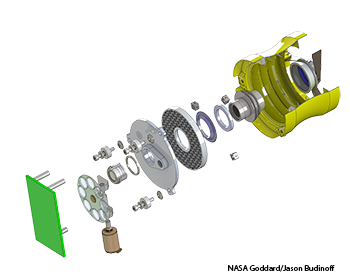
The 50 mm imaging telescope for a Cubesat-class satellite is being manufactured by NASA technologist Jason Budinoff using 3-D printing.
Aerospace engineer Jason Budinoff at NASA Goddard Space Flight Center (Greenbelt, Md., U.S.A.) will soon assemble the first imaging space telescope using parts almost exclusively manufactured from 3-D printers. If successful, the development could reduce the cost and time to manufacture such precision instruments by an order of magnitude.
Budinoff’s fully functional telescope will have a 50 mm aperture in which the outer tube, baffles and optical mounts are printed as a single titanium structure. The small telescope is designed to be incorporated into a CubeSat, a tiny satellite comprised of several units each measuring about four inches on each side.
The telescope will have a conventionally fabricated optical glass mirrors and lenses. The project is expected to take three months to complete, at a fraction of the cost of traditional telescopes. The 3-D laser sintering used by Budinoff includes an infrared laser to melt and fuse metal powder into a structure from a computer-aided design model. Budinoff is also planning to use 3-D laser sintering to build a 350 mm dual-channel telescope, which is more representative of actual space telescopes, and an all-aluminum instrument.
In this proof-of-concept aluminum instrument, even the mirror will be aluminum. To overcome the typical porosity of aluminum that would affect the reflectivity of the mirror, the system will be treated with a process called hot isostatic pressing, which involves placing the unpolished mirror blank in a gas pressure chamber at 15,000 psi.
“I basically want to show that additive-machined instruments can fly,” said Budinoff in a press release.
The multipronged project, funded by the Goddard Internal Research and Development program, is expected to be complete in late September. Next year, the unit will be tested for its ability to withstand vibration, extreme temperatures and vacuum. In the next step of the project, Budinoff will experiment with printed parts made of Invar, a metal alloy material being developed by Goddard technologist Tim Stephenson.
